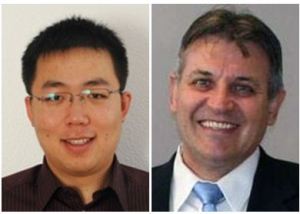A new method of microscopic drug delivery that could greatly improve the treatment of deadly pancreatic cancer has been proven to work in mice at UCLA’s Jonsson Comprehensive Cancer Center.
 Dr. Huan Meng and Dr. Andre Nel
Dr. Huan Meng and Dr. Andre Nel
The research team led by Drs. Andre Nel, professor of nanomedicine, and Huan Meng, adjunct assistant professor of nanomedicine, published the results of their study in the journal ACS Nano online this week ahead of print.
Pancreatic cancer (pancreatic ductal adenocarcinoma or PDAC) is a deadly disease that is nearly impossible to detect until it is in the advanced stage. Treatment options for it are very limited in number and suffer low success rates. The need for innovative and improved treatment of pancreatic cancer cannot be overstated, as its diagnosis over the years has consistently remained synonymous with a death sentence.
In the pancreas, PDAC tumors consist of cancer cells that are surrounded by other structural elements called stroma. These stroma can be made of many substances, such as collagen cells, and can block standard chemotherapy from efficiently reaching the cancer cells, hence reducing the effectiveness of the treatment. These stroma cells that surround the cancer cells are called pericytes.
The two-wave nanotherapy method employed by Drs. Nel and Meng in their research uses two different kinds of microscopic particles (nanoparticles) injected into the vein of the patient, one after the other in waves. The first wave of nanoparticles carries a substance that “opens the gate” to access the pancreas cancer cells and the second wave carries the chemotherapy drug that kills the cancer cells.
Drs. Nel and Meng and colleagues sought to contain chemotherapy in nanoparticles that could more directly target pancreas cancer cells, but they needed to find a way for those nanoparticles to get through the pericytes that restrict access to the cancer cells.
Through experimentation they discovered they could interfere with a protein signaling pathway (the way cells communicate with each other) that drew the pericytes to the cancer cells. By making nanoparticles that contain this pathway inhibitor, they created a first wave of nanoparticles that separates the pericytes from the cancer cells and opens the access gate for the next wave of nanoparticles, which carry the chemotherapy through the gate and directly to the cancer cells.
To test this two-wave nanotherapy, the researchers used specially bred mice with human pancreas tumors (called xenografts) attached to them. With the two-wave method, the xenograft tumors had a significantly higher rate of shrinkage compared to those exposed to chemotherapy given the standard way as a free drug in the blood stream.
“This two-wave nanotherapy is a shining example of how we seek to improve delivery of chemotherapy drugs to their intended targets,” said Nel, chief of the division of nanomedicine.“It shows that nanotechnology developed through integration with other scientific disciplines can help cancer patients by increasing the effectiveness of chemotherapy while greatly reducing side effects and toxicity. The step-wise engineered approach can also address biological impediments in nanotherapies for other types of cancer.”
This research was funded by the U.S. Public Health Service and the National Cancer Institute.
UCLA's Jonsson Comprehensive Cancer Center has more than 240 researchers and clinicians engaged in disease research, prevention, detection, control, treatment and education. One of the nation's largest comprehensive cancer centers, the Jonsson center is dedicated to promoting research and translating basic science into leading-edge clinical studies. In July 2013, the Jonsson Cancer Center was named among the top 12 cancer centers nationwide by U.S. News & World Report, a ranking it has held for 14 consecutive years. For more information on the Jonsson Cancer Center, visit our website at http://www.cancer.ucla.edu.
Source: http://www.cancer.ucla.edu/